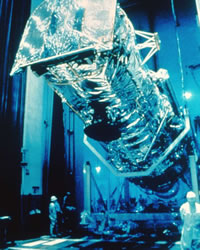 |
|
Satellite TechnologyToday’s satellite industry is committed to expanding the utilization of satellite technology for the broadcast delivery of video, data and voice services. How are Satellites possible?
Satellite ProgrammingSatellite programmers broadcast, or uplink, signals to a satellite which they either own or lease channel space from. The signals are often scrambled, or encrypted, to prevent unauthorized reception before they are retransmitted to a home antenna. The uplinked signals are received by a transponder located on the satellite, a device that receives the signals and transmits them back to the earth after converting them to a frequency that can be received by a ground-based antenna. Typically there are 24 to 32 transponders on each satellite. In order to minimize interference between the transponders, the signals are transmitted with alternately polarized antennas. Each satellite occupies a particular location in orbit, and operates at a particular frequency assigned by the FCC. Satellite SignalsThe signals received at the satellite from a ground-based antenna are extremely weak in amplitude – much less than one watt. As a result, they must employ amplifiers that boost the signals to a level that can successfully be processed and retransmitted to the earth. After traveling 22,000 miles to a ground-based antenna, the signals are again very weak and must be amplified. Therefore, satellite “dishes” focus the signals onto the actual antenna. The signals from the antenna are then fed to a “low-noise block,” or LNB, amplifier which amplifies signal and converts them to a lower frequency. The lower the power of the satellite, the larger the antenna required to focus the signals. A C-Band satellite, with power ranging between 10 and 17 watts per transponder, typically has an antenna between 5 and 10 feet in diameter; whereas a high-powered Ku-Band satellite, with a range of 120 to 240 watts per transponder, only requires an antenna 18 inches in diameter. The signals from the antenna are fed to an integrated receiver/decoder (IRD), which converts them to a form that can be viewed on a standard TV set. Every IRD contains a unique address number, which is activated by a installer/consumer to allow it to receive subscription services. In addition, the IRDs modem port is connected to a telephone line, in order to access pay-per-view ordering services and transmit other data. A single IRD can supply one channel choice to one or more TV sets. In order to view two different programs at the same time on two different TV sets, two IRDs are required—one for each TV, and the antenna must be a dual-LNB type. Satellite Home Viewer Improvement Act (SHIVA)Since the passing of the Satellite Home Viewer Improvement Act (SHVIA) in 1999, satellite TV companies have begun to offer local programming to many areas throughout the United States. For those areas where local TV signals are not being offered via satellite, satellite systems offer built-in electronic A/B switches. With a single push of a button on the remote control, consumers can toggle between satellite and off-air or cable TV signals. Satellite VS. CableSatellite TV offers a distinct technological advantage over cable TV systems: cable operations are essentially satellite operations in that cable networks receive their programming via satellite but then re-transmit the signals through the cable companies' trunk lines, which degrade the audio and video signals to a greater or lesser degree on the way to the customer’s home. Satellite TV, on the other hand, eliminates the intervening wiring and provides a direct link from the satellite to the customer’s antenna in a 100% digital video and audio feed. |
|



 Satellite broadcasting is made possible by the fact that communications satellites are fixed in geosynchronous orbit 22,300 miles above the equator, staying in the same position above the ground at all times. This allows satellite antennas that transmit and receive signals to be aimed at an orbiting satellite and left in a fixed position.
Satellite broadcasting is made possible by the fact that communications satellites are fixed in geosynchronous orbit 22,300 miles above the equator, staying in the same position above the ground at all times. This allows satellite antennas that transmit and receive signals to be aimed at an orbiting satellite and left in a fixed position.